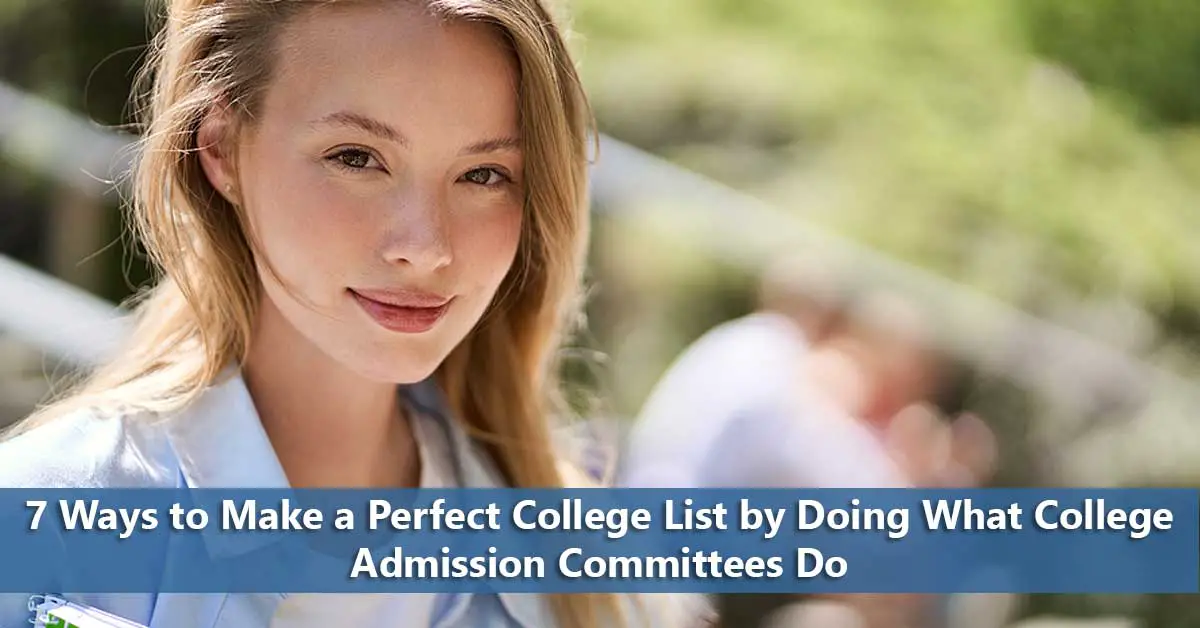 With all the pressure on high school students to create a perfect college list, they really aren’t given the opportunity to develop the skills to do so. It’s the sort of situation that most students will do only once. How often can you “practice” deciding which colleges to apply to? It’s not the same as practicing taking the ACT or SAT. How do you learn to create a list of colleges to apply to?
With all the pressure on high school students to create a perfect college list, they really aren’t given the opportunity to develop the skills to do so. It’s the sort of situation that most students will do only once. How often can you “practice” deciding which colleges to apply to? It’s not the same as practicing taking the ACT or SAT. How do you learn to create a list of colleges to apply to?
Of course, there are high school counselors who help hundreds of students create lists every year. And there are private college counselors who guide dozens of students through the process on an annual basis as well. Both are reasonable sources for help in deciding how to create your list. But there is an obvious although overlooked example that has a well-established method of creating a similar list as part of the same college admissions process: the colleges themselves.
Think about it. They review hundreds, more often thousands, of applications to decide which students to offer admissions to create the perfect class. Each year, they have to decide which students they’ll accept knowing that a large percentage of them will decide to go elsewhere. It’s pretty common for a school to create a desired list of future students knowing that only 20% to 30% are likely to accept. Yet, regardless of any variations in their yield rates, the colleges tend to handle admissions pretty much in the same manner. And if you take a look at their process, it can serve as a model for high school students trying to decide what schools to include on their perfect college list.
1. The Perfect College List starts with goals
Colleges have a list of goals for their class. Students always hear about how they weren’t admitted because the school needed an oboe player for this year’s class. The admissions committee knows that they want a certain number of students to fill various “buckets” of different kinds of students. These can be oboe players, football linebackers, chemistry majors, rural students, full-pay students, etc. Some students may fit into more than one bucket. The committee also knows that they won’t be able to get everything they want (unless they’re Harvard or the like) and so will have priorities for their goals as well.
High school students can do the same. While most of the goals will be their own such as size, major, and location, some will come from their family. Just as the admission committee has to deal with the administration giving them a budget to spend on financial aid, high school students can expect the same thing from their parents.
2. Colleges use numbers to create the pool of possibilities
It’s the reason why juniors find their mailboxes overflowing with brochures and viewbooks they never asked for. Their mailboxes, real life and online, are filled because colleges have identified them as possible prospects for their class based on available numbers. These numbers are likely to include test scores, GPA, and zip code. It may also include students having checked off a box for a specific major or college size preference. Colleges, most anyway, aren’t prepared to offer admissions based on these numbers but it creates the universe of potential applicants for them.
High school students can do the same. Use basic preferences to create a potential list of 30 to 50 schools to consider. These are schools that meet the basic numbers you can derive from your goals. Of course, it doesn’t take much to make it difficult to come up with 30 schools if your initial requirements are too strict. Broader is better. Start with a wide funnel and then narrow. Just like these aren’t the students the colleges are going to admit at this point, this is not the list of schools you’re going to apply to. The DIY College Rankings Spreadsheet is the perfect tool to create a potential list of colleges.
3. Compare prospects in the same bucket
Remember, the admissions committees have those buckets. And while they may not pay much attention to them at the beginning of the process when they’re just trying to admit the best students, they have to make sure they’re meeting their priorities. Ultimately, they aren’t comparing the oboe players’ and the football linebackers’ academic records. Students from rural high schools aren’t being compared to those from large suburban schools. They’re in different buckets, They are comparing the oboe players to each other and deciding which have the best oboe player qualifications.
Students should do the same thing when deciding which schools to include on their perfect college list. Not every school will be able to match all of their goals. Given the cost differences, it doesn’t make sense to compare class size or graduation rates between public and private universities (unless you’re going to be paying out-of-state tuition.) Basically, compare your safety schools to safety schools and reach schools to reach schools.
Join other parents in the Coffee Cup College Planning Facebook Group
4. They go beyond numbers
One way admission committees distinguish students that otherwise have very similar qualifications for their bucket is to consider their essays. Admission committees use the essays to get to know the students better. It’s an imperfect process. Not everyone can write a great essay. But it’s what they have to work with. They use the essays to decide if this is the kind of student they want to spend the next four years with.
Students can do something similar through the campus tour. It has the same limitations, little things can have an outsized influence on the student’s perception. However, students, unlike the admission officers, have the ability to dig further into the campus culture and academics through multiple avenues. This includes contacting current students directly, digging into the school newspaper, and requesting meetings with faculty.
5. Colleges use recommendations from experts
Letters of recommendation allow admission committees to “consult” outside experts for more information on the applicants. One thing the letters of recommendations do is give an idea of how the teacher compares the students to all of the other students the teacher has taught. This is a valuable comparison data point.
While students can get recommendations from other students or graduates of the college, they won’t have the same ability to compare it to their experience going to another school (generally.) The closest the student will come is people in charge of hiring college graduates or someone who has worked with a variety of graduates in their field. This is where job shadowing and information interviews with professionals in their field of interest can become very valuable.
6. They have a budget
Colleges have set budgets for need-based and merit-based financial aid. The admissions committees know how much merit money they can offer their first-choice students. Even if they really want a student, they usually have only limited ability to offer their top choices more money should they ask. They have to bring in a class and still be able to pay the bills.
Students should know what their budget is for college. They can include schools on their perfect college list but if the merit money or financial aid doesn’t come through, they should be prepared to move on.
7. Set a minimum standard
Even the last students the committee admits will meet the college’s minimum standards. They are students they expect to succeed on their campus. It’s expensive for colleges to have to replace empty seats should students flunk out or transfer.
Students can set minimum standards as well. It could be requiring a specific major such as nursing, a maximum size, or a minimum graduation rate. All the schools on a perfect college list will meet this minimum. Naturally, most will exceed them. Students need to set a minimum such that they will be happy and be able to succeed at any school that meets them.
How to start creating your perfect college list
If you’re still not sure how to start creating your perfect list, the “7 Days to a Smarter College List” is the “perfect” way to start. It’s a complete step-by-step process to identify potential schools that will meet your family’s academic and financial needs. Before you decide you need to hire an independent education consultant (a private college counselor), see what you’re capable of yourself.


